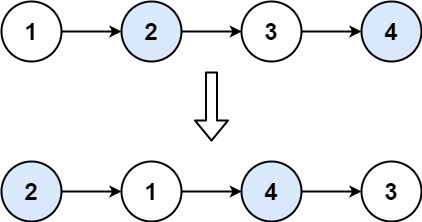给定一个链表,两两交换其中相邻的节点,并返回交换后的链表。
你不能只是单纯的改变节点内部的值,而是需要实际的进行节点交换。
示例 1:
输入:head = [1,2,3,4] 输出:[2,1,4,3]
示例 2:
输入:head = [] 输出:[]
示例 3:
输入:head = [1] 输出:[1]
提示:
- 链表中节点的数目在范围
[0, 100]内 0 <= Node.val <= 100
进阶:你能在不修改链表节点值的情况下解决这个问题吗?(也就是说,仅修改节点本身。)
设置虚拟头节点 dummy,pre 指针初始指向 dummy,遍历链表,每次交换 pre 后面的两个节点即可。
# Definition for singly-linked list.
# class ListNode:
# def __init__(self, val=0, next=None):
# self.val = val
# self.next = next
class Solution:
def swapPairs(self, head: ListNode) -> ListNode:
dummy = ListNode(next=head)
pre, cur = dummy, head
while cur and cur.next:
t = cur.next
cur.next = t.next
t.next = cur
pre.next = t
pre, cur = cur, cur.next
return dummy.next/**
* Definition for singly-linked list.
* public class ListNode {
* int val;
* ListNode next;
* ListNode() {}
* ListNode(int val) { this.val = val; }
* ListNode(int val, ListNode next) { this.val = val; this.next = next; }
* }
*/
class Solution {
public ListNode swapPairs(ListNode head) {
ListNode dummy = new ListNode(0, head);
ListNode pre = dummy, cur = head;
while (cur != null && cur.next != null) {
ListNode t = cur.next;
cur.next = t.next;
t.next = cur;
pre.next = t;
pre = cur;
cur = cur.next;
}
return dummy.next;
}
}/**
* Definition for singly-linked list.
* function ListNode(val, next) {
* this.val = (val===undefined ? 0 : val)
* this.next = (next===undefined ? null : next)
* }
*/
/**
* @param {ListNode} head
* @return {ListNode}
*/
var swapPairs = function(head) {
const dummy = new ListNode(0, head);
let pre = dummy;
let cur = head;
while (cur && cur.next) {
const t = cur.next;
cur.next = t.next;
t.next = cur;
pre.next = t;
pre = cur;
cur = cur.next;
}
return dummy.next;
};/**
* Definition for singly-linked list.
* struct ListNode {
* int val;
* ListNode *next;
* ListNode() : val(0), next(nullptr) {}
* ListNode(int x) : val(x), next(nullptr) {}
* ListNode(int x, ListNode *next) : val(x), next(next) {}
* };
*/
class Solution {
public:
ListNode* swapPairs(ListNode* head) {
ListNode *dummy = new ListNode(0, head);
ListNode *pre = dummy, *cur = head;
while (cur != nullptr && cur->next != nullptr) {
ListNode *t = cur->next;
cur->next = t->next;
t->next = cur;
pre->next = t;
pre = cur;
cur = cur->next;
}
return dummy->next;
}
};/**
* Definition for singly-linked list.
* type ListNode struct {
* Val int
* Next *ListNode
* }
*/
func swapPairs(head *ListNode) *ListNode {
dummy := &ListNode{0, head}
pre, cur := dummy, head
for cur != nil && cur.Next != nil {
t := cur.Next
cur.Next = t.Next
t.Next = cur
pre.Next = t
pre = cur
cur = cur.Next
}
return dummy.Next
}# Definition for singly-linked list.
# class ListNode
# attr_accessor :val, :next
# def initialize(val = 0, _next = nil)
# @val = val
# @next = _next
# end
# end
# @param {ListNode} head
# @return {ListNode}
def swap_pairs(head)
dummy = ListNode.new(0, head)
pre = dummy
cur = head
while !cur.nil? && !cur.next.nil?
t = cur.next
cur.next = t.next
t.next = cur
pre.next = t
pre = cur
cur = cur.next
end
dummy.next
end
